
The Coronavirus disease (COVID-19) underscored the supply chain’s importance in driving healthcare’s digital transformation. In theory, the supply chain is the repository for a treasure trove of data on products, including price, use and outcomes. However, the pandemic quickly unearthed detrimental fissures in the global supply chain. An overreliance on just-in-time (JIT) procurement strategies and a lack of industry-wide data sharing left many healthcare providers in the dark, unable to predict critical supply shortages or find alternative solutions.
As healthcare forges a path to financial recovery, expect to see a focus in 2021 on building more resilient supply chains. This will be driven in large part through the adoption of cloud-based technologies that can be coupled with supply chain data to drive the transparency and insights needed to help the industry be prepared the next time crisis strikes.
Below are five predictions for how the healthcare supply chain will continue to modernize and drive the industry’s digital transformation.
The move to value-based care will accelerate breaking down silos in the organization and the technology infrastructure. There will be a shift in 2021 to cross-functional teams that align with a patient’s entire care episode, resulting in a better understanding of product utilization and the total cost of care. To gain the necessary insights, these teams will require more modern technologies and better systems integration. For example, the move to cloud enterprise resource planning (ERP) will make it easier to identify, locate, procure and bill items that align with specific patient needs. Success, however, will necessitate core supply chain data that is clean, current, accurate and easily managed. In addition, providers and suppliers will increasingly find ways to better share data to create greater visibility around inventory and demand. These partnerships will help create new contracting models involving shared risk.
The era of post-modern ERP will dawn in healthcare marked by widespread adoption of cloud solutions and enterprise modernization. In 2021, the big winners will be organizations that move to a cloud-based ERP and invest in enterprise modernization to ensure data integrity. Health networks need the ability to adapt to trends, including telehealth, managing remote clinicians and extending the supply chain to the patient’s home. Organizations that make the move to cloud ERP and modernization will improve processes and make better-informed supply chain decisions based on accurate and current data-driven insights.
Hospitals with stronger balance sheets will drive more market consolidation. Look for more merger and acquisition activity in the areas of non-acute care and home health. According to data from HealthCareMandA.com and Deal Search Online, deal volume in the home health and hospice sector accelerated in the third quarter of 2020 with M&A activity increasing 10% compared with the same quarter in 2019. Consolidation will be driven by larger integrated delivery networks and health systems in stronger financial positions and have focused on transitioning to value-based care. The supply chain has an important role to play in helping to facilitate seamless integration of data and processes during the M&A process.
The industry’s focus on supply chain resiliency will transform healthcare into a “team sport.” The COVID-19 pandemic highlighted the power of collaboration in solving complex problems. During the year ahead, expect to see more collaboration, including the formation of regional collaboratives, greater investment in data management and forecasting initiatives by suppliers and providers, reliance on more clinical evidence to drive purchasing decisions, heightened transparency between providers and suppliers and exploration of stockpile strategies that share cost, rotate to avoid expirations and create supply buffers to avoid future shortages. For instance, during the early days of the pandemic, Medtronic, Boston Scientific and the University of Minnesota combined forces to design a lightweight ventilator. These creative collaborations will increasingly become the industry norm.
Data standards will be more broadly adopted to support immediate pandemic and future emergency response needs. COVID-19 raised awareness of the importance of standardization, whether identifying products and locations or reporting potential and actual supply continuity risks. In 2021, expect actions around the broader adoption of standardization to support the pandemic and emergency response. Broader adoption of data standards will help the healthcare industry increase efficiency, lower costs and improve patient safety.
Click here to hear how blockchain can help data in the pharma supply chain:
Despite the many hardships the healthcare industry has navigated during the past year, COVID-19 has accelerated the opportunity for industry transformation. Although the pandemic persists, supply chain teams have not sat idle. They have been developing best practices and discussing lessons learned, which point to a need for greater investment in technologies, partnerships and processes that facilitate a balance between resiliency, financial health and agility. Now is the time for the industry to put this knowledge to work and create a supply chain that enables us to improve patient care during the best and the worst times.













